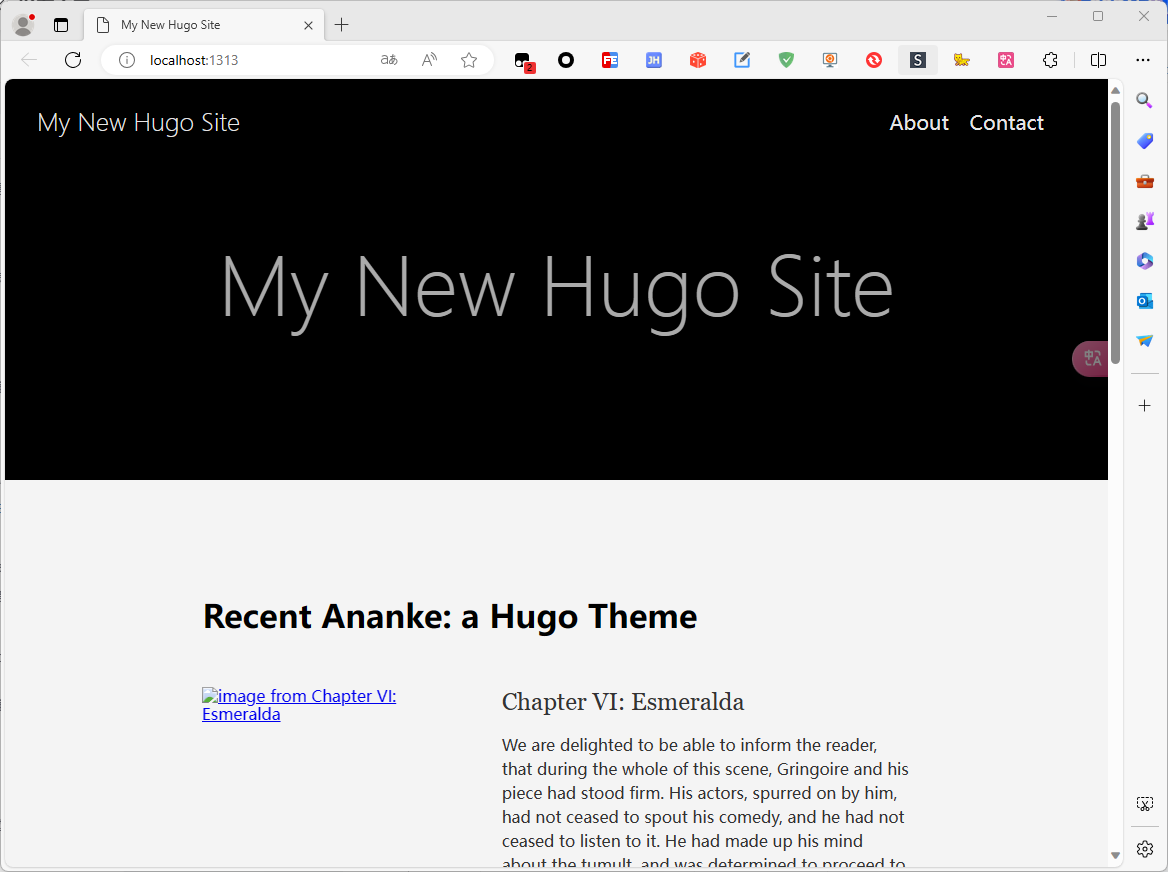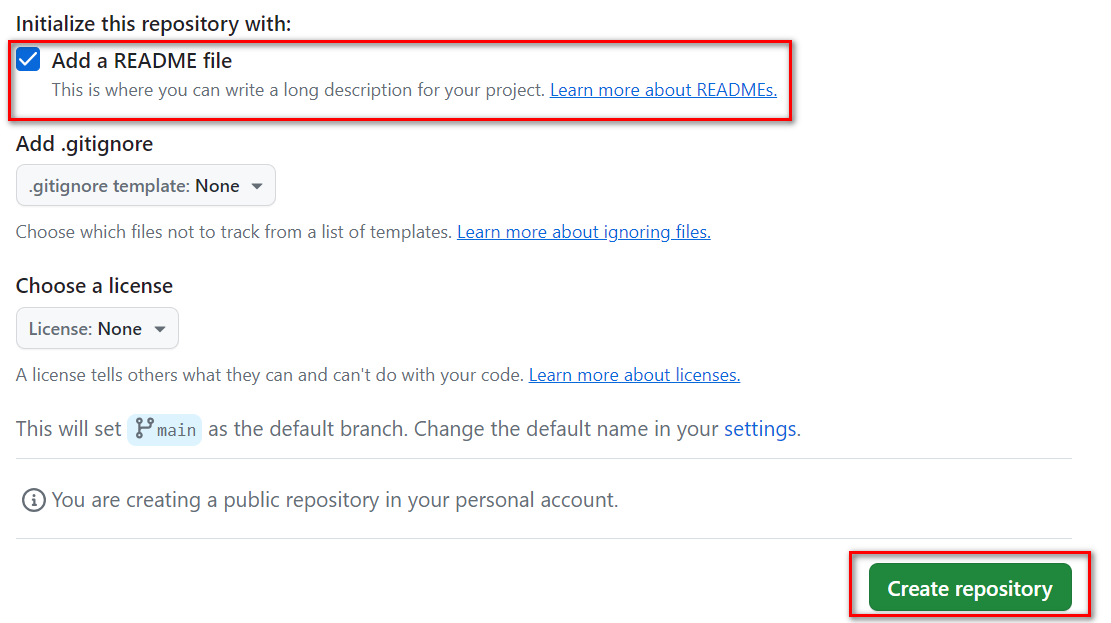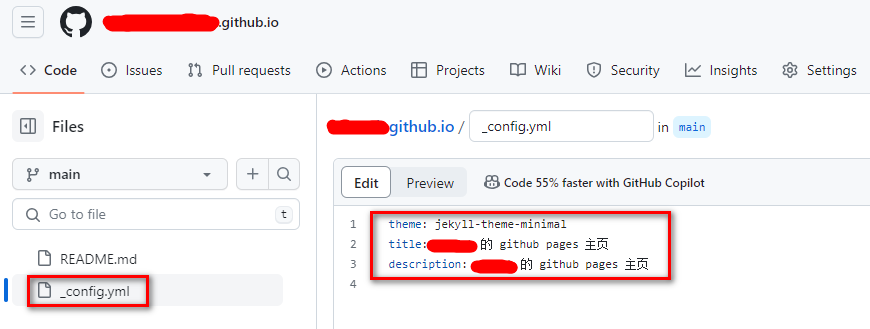使用 Github、Hugo 搭建个人博客
Hugo 静态网站构建手册:https://jimmysong.io/hugo-handbook/
关键字:开源 博客 框架
?
1、GitHub?Pages
官网:https://pages.github.com/
文档:https://docs.github.com/zh
Github?Pages?简介
Websites for you and your projects. (为你的项目提供网站)。GitHub Pages 是通过 GitHub 托管和发布的公共网页。Github Pages 本质上是一个静态网站托管系统,可以使用它为你的每一个仓库制作一个静态网页入口。
- 搭建简单而且免费;
- 支持静态脚本;
- 可以绑定你的域名;
- DIY自由发挥,动手实践一些有意思的东西git,markdown,bootstrap,jekyll;
- 理想写博环境,git+github+markdown+jekyll;
Git、GitHub、GitHub?Pages
- Git 是一个开源的分布式版本控制系统。
- GitHub?是托管各种 git 库的站点。
- GitHub?Pages 是免费的静态站点。可以免费托管、自带主题、支持自制页面和Jekyll。
GitHub Pages?文档
官网文档(英文):https://docs.github.com/en/pages
官网文档(中文):https://docs.github.com/zh/pages
GitHub Pages 是通过 GitHub 托管和发布的公共网页。 启动和运行的最快方法是使用 Jekyll 主题选择器加载预置主题。 然后修改 GitHub Pages 的内容和样式。
创建 网站
首先需要?github?账号,没有就注册一个。
1. 在任何页面的右上角选择 + ,单击?新建仓库。输仓库名。仓库名必须以 .github.io?结尾?
然后勾选 "添加?README.txt"
2.?进入创建的仓库,点击 设置,在 "左边的侧边栏"? 的 "代码和自动化"?部分,点击?页面,在 "构建和部署" 下的 "源"?选择 "从分支部署",在 "分支"?下选择发布源?为?None,然后保存。
3. (可选),打开仓库中的?README.md?文件,可以保持默认也可以编辑,这个文件是编写你网站内容的位置。
4.?修改并推送到 GitHub 后,最长可能需要 10 分钟才会发布。
访问发布后的网站。
更改标题和说明。单击仓库的 “代码” 选项卡,添加 _config.yml文件,编辑_config.yml 添加如下内容,编辑完文件后,单击“提交更改”
theme: jekyll-theme-minimal
title:?xxx?的 github pages 主页
description: xxx的 github pages 主页
站点添加主题:使用 Jekyll 向 GitHub Pages 站点添加主题 - GitHub 文档
网站的 2种 pages 模式
两种 pages 模式
- 个人或公司站点:User/Organization?Pages。
? ? 使用自己的用户名,每个用户名下面只能建立一个;主干上内容被用来构建和发布页面 - 项目站点:Project?Pages。gh-pages分支用于构建和发布;
如果user/org pages使用了独立域名,那么托管在账户下的所有project pages将使用相同的域名进行重定向,除非project pages使用了自己的独立域名;
如果没有使用独立域名,project pages将通过子路径的形式提供服务http://username.github.com/projectname;
自定义404页面只能在独立域名下使用,否则会使用User Pages 404;
常用命令
$ git clone git@github.com:username/username.github.com.git?
//本地如果无远程代码,先做这步,不然就忽略
$ cd .ssh/username.github.com //定位到你blog的目录下
$ git pull origin master?
//先同步远程文件,后面的参数会自动连接你远程的文件
$ git status //查看本地自己修改了多少文件
$ git add . //添加远程不存在的git文件
$ git commit * -m "what I want told to someone"
$ git push origin master //更新到远程服务器上
项目 站点:Project?Pages
- gh-pages分支用于构建和发布;
- 如果user/org?pages使用了独立域名,那么托管在账户下的所有project?pages将使用相同的域名进行重定向,除非project?pages使用了自己的独立域名;
- 如果没有使用独立域名,project?pages将通过子路径的形式提供服务http://username.github.com/projectname;
- 自定义404页面只能在独立域名下使用,否则会使用User?Pages?404;
创建项目站点步骤:
$ git clone https://github.com/USERNAME/PROJECT.git PROJECT
$ git checkout --orphan gh-pages
$ git rm -rf .
$ git add .
$ git commit -a -m "First pages commit"
$ git push origin gh-pages
建立主站、二级应用页面
可以通过 User/Organization?Pages建立主站,而通过Project?Pages挂载二级应用页面。
入门
配置 自定义 域
2、部署?博客
使用?Github?Pages?创建并部署网站。
安装 git 工具:https://git-scm.com/downloads
github?桌面版:https://desktop.github.com/
搭建静态页面网站的技术有很多,目前有三种主流技术选型:Hogo是 Go 语言,Hexo是 nodejs,jekyll 是 Ruby。都是静态网站生成器。
Jekyll
官网
Jekyll?是一个简单的博客形态的静态站点生产机器。它有一个模版目录,其中包含原始文本格式的文档,通过一个转换器(如?Markdown)和?Liquid?渲染器转化成一个完整的可发布的静态网站,你可以发布在任何你喜爱的服务器上。Jekyll?也可以运行在?GitHub Page?上,也就是说,你可以使用 GitHub 的服务来搭建你的项目页面、博客或者网站,而且是完全免费的。说白了就是,只要安装Jekyll的规范和结构,不用写html,就可以生成网站。
jekyll 与 github 的关系:GitHub?Pages一个由?GitHub?提供的用于托管项目主页或博客的服务,jekyll 是后台所运行的引擎。
GitHub Pages 建立个人网站详细教程:https://zhuanlan.zhihu.com/p/58229299
使用 Jekyll 设置站点
Hugo (雨果)
Hugo 官网描述说是世界上最快的、最受欢迎的开源静态网站生成器。hugo是用Go语言编写的静态网页生成器,只需要一个命令?hugo?就可以在几秒钟内生成一个静态的博客页面。
Website?|?Installation?|?Documentation?|
官网文档
- Installation?安装
- Getting started?开始
- Content management?内容管理
- Templates?模板
- Functions?功能
- Methods?方法
- Quick reference?快速参考
- Variables?变量
- Hugo Modules?Hugo模块
- Hugo Pipes?雨果派普斯
- CLI
快速入门、目录结构、hugo配置
- 如果是 Windows 用户:不要使用 命令提示符,不要使用 "Windows PowerShell"。
- "PowerShell" 和 "Windows PowerShell" 是不同的应用程序。
- 可以使用?"PowerShell" 或 Linux 终端(如 WSL 或 Git Bash)运行?hugo?命令。
在使用 Hugo 静态网站生成器时,你可能会遇到 hugo.toml 和 config.toml 这两个配置文件。
- hugo.toml 是 Hugo 项目的主要配置文件,通常位于 Hugo 项目的根目录下。它包含了许多配置选项,用于指定网站的各种设置,例如语言、页面布局、URL 等。你可以使用文本编辑器打开 hugo.toml 文件,并根据你的需求进行相应的配置。
- config.toml 是 Hugo 的默认配置文件名称,也位于 Hugo 项目的根目录下。它是一个用户自定义的配置文件,用于存储网站的自定义设置。你可以在 config.toml 文件中添加自己的配置选项,以满足特定需求。Hugo 会自动加载并应用 config.toml 中的配置。
- 对于 Hugo 项目,只需要一个有效的配置文件,可以是 hugo.toml 或者 config.toml。如果同时存在这两个文件,Hugo 会优先加载 hugo.toml 文件。如果只有 config.toml 文件存在,则 Hugo 只加载该文件。
- 如果使用config.yml?配置文件需要注意:yml 是缩进敏感
开始使用
基本用法
- Test your installation?测试安装
- Display available commands显示可用命令
- Build your site?构建您的网站
- Draft, future, and expired content草稿、未来和过期内容
- Develop and test your site开发和测试您的网站
- Deploy your site?部署站点
目录结构
配置 Hugo
- Configuration file?配置文件
- Configuration directory?配置目录
- Merge configuration from themes从主题合并配置
- All configuration settings所有配置设置
- Configure build?配置构建
- Configure cache busters?配置缓存破坏程序
- Configure server?配置服务器
- 404 server error page404 服务器错误页面
- Configure title case?配置标题大小写
- Configuration environment variables配置环境变量
- Configure with environment variables使用环境变量进行配置
- Ignore content and data files when rendering渲染时忽略内容和数据文件
- Configure front matter?配置前端
- Configure additional output formats配置其他输出格式
- Configure minify?配置缩小
- Configure file caches?配置文件缓存
- Configure cacheDir?配置 cacheDir
配置?markup
术语表:https://gohugo.io/getting-started/glossary/
关于Hugo的教程和书籍列表
- Hugo In Action Home Page:https://www.manning.com/books/hugo-in-action
- Hugo In Action 主页:https://www.manning.com/books/hugo-in-action
托管和部署
托管和部署 (Hosting and deployment)
- 概述
- 部署 Hugo
- 使用 Rclone 进行部署
- 使用 Rsync 部署
- 托管部署到 21YunBox
- 托管部署到 AWS Amplify
- 托管部署到 Azure 静态 Web Apps
- 托管部署到 Cloudflare Pages
- 托管部署到 Firebase
- 托管部署到 GitHub Pages
- 托管部署到 GitLab Pages
- 托管部署到 KeyCDN
- 托管部署到 Netlify
- 托管部署到 Render
其他托管网站的平台
- Netlify:做的一些 Vue 或者 React 想上线部署之后可以让别人预览,可以通过 Netlify 这个平台实现
- Nanobox:本地开发工具,可以消除环境的复杂性,在部署和生产环境之间,进行自动化环境配置,通过虚拟化使得开发环境更简洁
- AWS Amplify:亚马逊出品的移动应用开发程序管理工具
- Firebase:Google 出品的 BAAS
hugo 主题?库
hugo?官方的主题库,可以搜索、下载喜欢的主题:https://themes.gohugo.io/

使用 Hugo 创建静态网站
Github Pages 是一个静态网站托管系统,可以为每个仓库制作一个静态网页入口。它有两种存在方式:
- 识别 master branch 根目录下的:README.md 或者 index.html
- 识别 master branch 的 /docs 目录下的:README.md 或者 index.html
也就是说:可以把我们的静态网页直接存在 master branch,并在 Github Repository 的 Setting 页中打开 Github Pages 选项,就可以通过一个域名访问到我们的想要的网站了。
将 Hugo 部署为 GitHub Pages 项目或个人/组织站点,并使用 GitHub Actions 自动执行整个过程
- Prerequisites?先决条件
- Types of sites?网站类型
- Procedure?程序
- Customize the workflow?自定义工作流
- Additional resources?其他资源
安装?Hugo
下载:https://github.com/gohugoio/hugo
Hugo 有两个版本:标准版和扩展版。扩展版功能:在处理图像时编码为 WebP 格式,可以使用任一版本解码 WebP 图像;使用嵌入式 LibSass 转译器将 Sass 转译为 CSS,使用 Dart Sass 转译器不需要扩展版。查看 Hugo 是否安装成功:hugo --help

使用 "hugo [command] --help" 查看对应命令的帮助。
用法:
? hugo [flags]
? hugo [command]可用命令:
? completion ?为指定的shell生成自动完成脚本
? config ? ? ?打印 site 配置
? convert ? ? 将内容转换为不同的格式
? deploy ? ? ?将站点部署到云提供商。
? env ? ? ? ? 打印 Hugo 版本和环境信息
? gen ? ? ? ? 几个有用的生成器的集合。
? help ? ? ? ?帮助
? import ? ? ?从其他站点导入您的站点。
? list ? ? ? ?列出各种类型的内容
? mod ? ? ? ? 各种Hugo模块帮助
? new? ? ? ? ?为?web 站点创建?网站内容
? server ? ? ?一个高性能的 webserver
? version ? ? 打印 Hugo 版本和环境信息Flags:
? -b, --baseURL string ? ? ? ? ? ? hostname (and path) to the root, e.g. https://spf13.com/
? -D, --buildDrafts ? ? ? ? ? ? ? ?include content marked as draft(草案、草稿)
? -E, --buildExpired ? ? ? ? ? ? ? include expired content
? -F, --buildFuture ? ? ? ? ? ? ? ?include content with publishdate in the future
? ? ? --cacheDir string ? ? ? ? ? ?filesystem path to cache directory
? ? ? --cleanDestinationDir ? ? ? ?remove files from destination not found in static directories
? ? ? --clock string ? ? ? ? ? ? ? set the clock used by Hugo, e.g. --clock 2021-11-06T22:30:00.00+09:00
? ? ? --config string ? ? ? ? ? ? ?config file (default is hugo.yaml|json|toml)
? ? ? --configDir string ? ? ? ? ? config dir (default "config")
? -c, --contentDir string ? ? ? ? ?filesystem path to content directory
? ? ? --debug ? ? ? ? ? ? ? ? ? ? ?debug output
? -d, --destination string ? ? ? ? filesystem path to write files to
? ? ? --disableKinds strings ? ? ? disable different kind of pages (home, RSS etc.)
? ? ? --enableGitInfo ? ? ? ? ? ? ?add Git revision, date, author, and CODEOWNERS info to the pages
? -e, --environment string ? ? ? ? build environment
? ? ? --forceSyncStatic ? ? ? ? ? ?copy all files when static is changed.
? ? ? --gc ? ? ? ? ? ? ? ? ? ? ? ? enable to run some cleanup tasks (remove unused cache files) after the build
? -h, --help ? ? ? ? ? ? ? ? ? ? ? help for hugo
? ? ? --ignoreCache ? ? ? ? ? ? ? ?ignores the cache directory
? ? ? --ignoreVendorPaths string ? ignores any _vendor for module paths matching the given Glob pattern
? -l, --layoutDir string ? ? ? ? ? filesystem path to layout directory
? ? ? --logLevel string ? ? ? ? ? ?log level (debug|info|warn|error)
? ? ? --minify ? ? ? ? ? ? ? ? ? ? minify any supported output format (HTML, XML etc.)
? ? ? --noBuildLock ? ? ? ? ? ? ? ?don't create .hugo_build.lock file
? ? ? --noChmod ? ? ? ? ? ? ? ? ? ?don't sync permission mode of files
? ? ? --noTimes ? ? ? ? ? ? ? ? ? ?don't sync modification time of files
? ? ? --panicOnWarning ? ? ? ? ? ? panic on first WARNING log?
? ? ? --poll string ? ? ? ? ? ? ? ?设置 poll 时间间隔, e.g --poll 700ms, 使用基于轮询的方法来监视文件系统的更改
? ? ? --printI18nWarnings ? ? ? ? ?print missing translations
? ? ? --printMemoryUsage ? ? ? ? ? print memory usage to screen at intervals
? ? ? --printPathWarnings ? ? ? ? ?print warnings on duplicate target paths etc.
? ? ? --printUnusedTemplates ? ? ? print warnings on unused templates.
? ? ? --quiet ? ? ? ? ? ? ? ? ? ? ?build in quiet mode
? ? ? --renderToMemory ? ? ? ? ? ? render to memory (only useful for benchmark testing)
? -s, --source string ? ? ? ? ? ? ?filesystem path to read files relative from
? ? ? --templateMetrics ? ? ? ? ? ?display metrics about template executions
? ? ? --templateMetricsHints ? ? ? calculate some improvement hints when combined with --templateMetrics
? -t, --theme strings ? ? ? ? ? ? ?themes to use (located in /themes/THEMENAME/)
? ? ? --themesDir string ? ? ? ? ? filesystem path to themes directory
? ? ? --trace file ? ? ? ? ? ? ? ? write trace to file (not useful in general)
? -v, --verbose ? ? ? ? ? ? ? ? ? ?verbose output
? -w, --watch ? ? ? ? ? ? ? ? ? ? ?watch filesystem for changes and recreate as needed
hugo new site?xxx? ? 创建站点
hugo new xxx? ? ? ? ? ?创建?站点内容,即 网页内容文件。
创建?网站
hugo new site 命令创建一个新的 Hugo 网站时,如果指定的目录不为空会报错。如果想要在非空目录中创建 Hugo 网站,可以先?hugo new site temp-site?创建一个临时的空目录,再将临时文件夹temp-site 中的内容移动到你想要的目标目录中。


- hugo new site ?在指定的目录创建一个站点,新创建的站点有正确的结构,但还没有内容和主题。
- 可以使用 hugo new [contentPath]? ? 创建 站点内容(网页文件)
添加?ananke?主题,并启动
在流行框架的基础上搭建网站其实并不是一个技术活,千差万别的网站体验则主要体现在网站主题的设计上。Hugo 提供丰富多样的主题模板,可以在主题库搜索喜欢的主题进行安装:https://themes.gohugo.io/
示例:安装 https://github.com/theNewDynamic/gohugo-theme-ananke?主题
- 方法 1:作为 Hugo 模块(推荐),需要安装Go。
在项目的根目录初始化hugo模块系统:hugo mod init github.com/<your_user>/<your_project>
添加主题仓库到?config.toml?文件:theme = ["github.com/theNewDynamic/gohugo-theme-ananke"]- 方法 2:作为 git 子模块。在Hugo站点根目录中运行:git submodule add https://github.com/theNewDynamic/gohugo-theme-ananke.git themes/ananke
- 方法 3:直接把主题 clone 到 theme 目录下。示例克隆 jane 主题:git clone https://github.com/xianmin/hugo-theme-jane.git --depth=1 themes/jane?
- git clone https://github.com/adityatelange/hugo-PaperMod themes/PaperMod --depth=1
git init
git submodule--helper add https://github.com/adityatelange/hugo-PaperMod.git themes/PaperMod --depth=1
hugo server -D 是用于在 Hugo 静态网站生成器中启动本地服务器的命令。
hugo: 是 Hugo 静态网站生成器的可执行命令。server: 是 Hugo 提供的一个子命令,用于启动本地开发服务器。-D(或?--buildDrafts): 是一个可选参数,用于告诉 Hugo 在构建网站时包括草稿(draft)文章。可以在预览网站时渲染未发布的草稿文档。
为了成功运行 hugo server -D 命令,需要先进入 Hugo 项目的根目录,然后再运行该命令。成功运行后将启动一个本地开发服务器,并自动监视你的 Hugo 项目文件夹中的更改。这意味着每当你编辑或添加新的内容时,服务器都会重新加载并显示最新的更改。在浏览器中打开 http://localhost:1313 即可访问 Hugo 生成的网站。
启动:hugo server? 后访问效果如下。

添加?博文,并启动
进入web?站点根目录,执行命令 hugo new post/test.md 或者 hugo new post/2021/test.md?创建博文。创建的文章会自动生成一部分文本。
如果嫌弃手动添加麻烦,目录?themes\ananke\exampleSite?是个样例站点,可以直接把?exampleSite?目录下的 "content目录 和?config.toml文件" 复制到自己创建站点的 根目录下,然后把?config.toml?里面的内容合并到?hugo.toml?里面,然后删除?config.toml

再次启动:hugo server? 后访问效果如下

总结步骤:
hugo?new site?my_hugo_web_src #?创建名为?my_hugo_web_src 的目录,作为根目录
cd my_hugo_web_src
git init ? ?##初始化仓库
git remote add origin https://github.com/caecarxu/caecarxu.github.io.git ? ?##链接远程仓库
git add .
git commit -m "first commit"
git push -u origin master
在此之后更新文章,使用hugo生成新的静态页面,并使用git push进行同步
cd my_hugo_web_src
git add .
git status
git commit -m "add blog post"
git push
提示以下,commit -m 后面的东西是此次提交的备注,通常用来说明提交人的名字
或者
在仓库页面可以获取到 clone 链接 git@github.com:$USER_NAME/xxx.github.io.git
git init -b main
git remote add upstream git@github.com:$USER_NAME/xxx.github.io.gitgit push -f upstream main
这样就部署成功了,等待几分钟后,访问网址:xxx.github.io即可看到自己的博客内容。
将网站部署到 Github Pages
Hugo 提供非常详尽的?GitHub Pages 部署指引。步骤如下:
- 1. 部署到?Github Pages?时,需要把?hugo.toml 文件中 baseURL 修改为自己博客的网址,譬如 baseURL = "https://caecarxu.github.io/"
- 2. 然后执行?hugo?命令生成静态页面文件,执行成功后出现一个 public 文件夹,里面就是网站的静态页面文件
- 3.?进入?public?目录,把目录中所有文件上传到?xxx.github.io?的仓库中。
进入 public 文件夹,使用 git 上传文件
cd public
git init ##初始化仓库
git remote add origin https://github.com/caecarxu/caecarxu.github.io.git ##链接远程仓库
git add .
git commit -m "first commit"
git push -u origin main
在此之后更新文章,使用hugo生成新的静态页面,并使用git push进行同步
cd public
git add .
git status
git commit -m "add blog post"
git push - 4. 每当写完文章,运行?
hugo?命令,Hugo 将自动生成静态网站到?public?文件夹中,只需要将该文件夹的内容发布在网络上即可。
部署成功后,网站依然略显简陋,可以通过配置 hugo.toml 中的配置项增加你想要的功能
增加 About 页面
博客默认菜单只有 4 个页面选项:Home,?Archives,?Tags,?Categories,如果想新增?About?页面,仅需以下 2 步:
- 新建 about 文件:hugo new about.md,命令将会创建?
contents/about.md?文件 - 在 about.md 文件的 Front Matter 中输入以下配置:
---
title: "About"
date: 2021-12-19T13:51:21+08:00
draft: false
menu: "main" ? ? # 在 main 新增选项?
weight: 50 ? ? ? # About 选项的位置
---
重新部署博客,可以看到新增了 About 选项。
转移目录至侧边栏
添加评论系统
giscus 是一个基于 GitHub Discussions 的评论系统,包含多种主题可供选择。你应该首先跟随?utterances 配置方法了解可选配置项,并根据个人偏好自动生成一份包含个性化配置属性的?HTML?代码:
博客使用 utterances 作为评论系统:https://juejin.cn/post/6844903834712539150
giscus:https://giscus.app/zh-CN
给 hugo 博客添加评论功能:https://segmentfault.com/a/1190000039217582
SEO 优化
写博客不只是为了记录,也是为了更好地去(man)帮(zu)助(xu)别(rong)人(xin),为了让搜索引擎更好地收录你的博客文章,还需要做一些搜索引擎优化(SEO),Even 主题已经提供了丰富的 SEO 优化手段,我们只需设置一些配置项。
- 最好在?
archtypes/default.md?中增加?keywords?和?description配置,便于搜索引擎索引。
keywords: []
description: "" -
网站目录 增加 robots 文件,便于爬虫爬取网页内容。不过 Even 已经提供了 robots 和相关的网页地图设置,因此这里无需操作。
-
提交博客地址到搜索引擎?Google
-
配置?Google Analytics,将获取到的 Tracking ID 配置到?
config.toml?中。
googleAnalytics = "" ? ? ?# UA-XXXXXXXX-X
使用 GitHub Action 自动发布文章
这里主要参考?搭建个人blog, 使用?master?分支发布文章,使用一个新的?source?分支进行写作,写作完成后上传?source?,GitHub Action 自动将?source?分支的?publish?文件夹拷贝到?master?分支,从而完成文章的发布。
主要步骤如下:
1. 在 GitHub 上的个人网站仓库
xxx.github.io?新建?source?分支
2. 清除文件夹?
xxx.github.io?中的内容,并将个人网站?quickstart?中的所有内容 copy 到?xxx.github.io?:
git clone --branch=source?https://github.com/xxx/xxx.github.io.git
rm -rf?woot!*
cp -rf quickstart/*?http://xxx.github.io
3. 生成?
ACTIONS_DEPLOY_KEY
ssh-keygen -t rsa -b 4096 -C "$(git config user.email)" -f gh-pages -N ""
将生成的私钥文件?gh-pages?(注意不是公钥?gh-pages.pub) 中的内容复制填写到 GitHub 仓库设置中,即在?xxx.github.io?项目主页中,找到 Repository Settings -> Secrets -> 添加这个私钥的内容并命名为?ACTIONS_DEPLOY_KEY?。
然后在?xxx.github.io?项目主页中,找到 Repository Settings -> Deploy Keys -> 添加这个公钥的内容,命名为?ACTIONS_DEPLOY_KEY?,并勾选 Allow write access。
4. 配置 workflow
创建 workflow 文件
mkdir -p .github/workflows/
touch .github/workflows/main.yml
在?main.yaml?中撰写 workflow,内容如下:
name: github pages
on:
push:
branches:
- source
jobs:
build-deploy:
runs-on: ubuntu-18.04
steps:
- uses: actions/checkout@master
- name: Checkout submodules
shell: bash
run: |
auth_header="$(git config --local --get http.https://github.com/.extraheader)"
git submodule sync --recursive
git -c "http.extraheader=$auth_header" -c protocol.version=2 submodule update --init --force --recursive --depth=1
- name: Setup Hugo
uses: peaceiris/actions-hugo@v2
with:
hugo-version: 'latest'
extended: true
- name: Build
run: hugo --gc --minify --cleanDestinationDir
- name: Deploy
uses: peaceiris/actions-gh-pages@v3
with:
deploy_key: ${{ secrets.ACTIONS_DEPLOY_KEY }}
publish_dir: ./public
publish_branch: main
注意,如果你的仓库是?master?分支作为主分支,将?publish_branch?后面的?main?修改为?master?;
5. 将 source 分支发送到远程
发送脚本?deploy.sh?:
#!/bin/bash
git add .
git commit -m "update article"
git push
推送到远程分支:
sh deploy.sh
推送成功后,可以在项目主页中的 action 里面查看自动部署是否成功,即?https://github.com/xxx/xxx.github.io/actions;
本文来自互联网用户投稿,该文观点仅代表作者本人,不代表本站立场。本站仅提供信息存储空间服务,不拥有所有权,不承担相关法律责任。 如若内容造成侵权/违法违规/事实不符,请联系我的编程经验分享网邮箱:chenni525@qq.com进行投诉反馈,一经查实,立即删除!
- Python教程
- 深入理解 MySQL 中的 HAVING 关键字和聚合函数
- Qt之QChar编码(1)
- MyBatis入门基础篇
- 用Python脚本实现FFmpeg批量转换
- Linux下shell脚本编写
- 使用服务器应该知道的安全软件
- this和super的详谈
- 数据结构-线性表及其应用(C++)
- blender Texture Coordinate Node
- 如何有效清理您的 Python 环境:清除 pip 缓存
- C++入门教程,C++基础教程(第一部分:从C到C++)七
- 【工具使用-A2B】使用A2B配置32通道车载音频系统
- 媒体AI解决方案
- 全网最全stable diffusion模型讲解!快来!!小白必收藏!!





